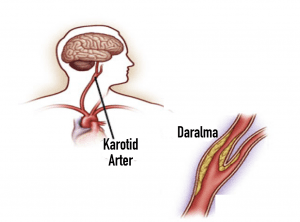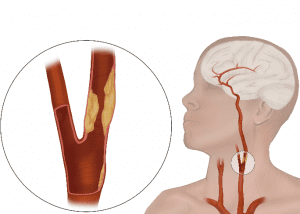What is a stroke? A stroke, also known colloquially as a ‘brain attack’, is a serious medical condition that occurs when blood flow to a part of the brain is suddenly cut off or reduced. Brain tissue damage can occur within minutes due to lack of oxygen. This life-threatening condition is among the most common causes of death worldwide. Fortunately, stroke is a preventable disease in some cases.
A stroke occurs when the blood carrying oxygen and nutrients to our brain is reduced or completely cut off due to a blood vessel blockage or brain hemorrhage. This can lead to brain cell death and permanent damage. Strokes are generally evaluated in two main groups:
- Ischemic Stroke: Occurs as a result of brain vessels being blocked by a clot. About 85% of all stroke cases fall into this group.
- Hemorrhagic Stroke: Occurs when a brain vessel ruptures and blood spreads into the brain tissue.
Why Does Blood Flow to the Brain Decrease?

The most important vessels carrying blood to the brain are known as carotid arteries. These vessels can narrow or become completely blocked over time due to atherosclerosis. Additionally, heart rhythm disorders (especially atrial fibrillation) can lead to clot formation in the heart. When these clots reach the brain, a stroke can develop.
Stroke Risk Factors
The main factors that increase the risk of having a stroke are:
- High blood pressure
- Diabetes
- High cholesterol
- Smoking
- Excess weight and obesity
- Family history of vascular disease
- Inactivity
- Heart rhythm disorders
What Are the Symptoms of a Stroke?
Stroke symptoms vary depending on the affected area of the brain. The most common symptoms are:
- Sudden numbness or weakness in the face, arm, or leg (especially on one side)
- Speech impairment or difficulty understanding words
- Vision loss or double vision
- Severe dizziness and loss of balance
- Confusion
- Difficulty swallowing
- Shortness of breath
- Urinary incontinence
- Difficulty walking
Can Strokes Be Prevented?
Yes, especially a large portion of ischemic strokes can be prevented. Controlling risk factors, maintaining a healthy lifestyle, and regular check-ups are very effective in this regard. When carotid artery narrowing or heart rhythm disorders are detected and treated early, the risk of stroke can be significantly reduced.

How Is Carotid Artery Blockage Detected?
Carotid artery blockage usually doesn’t show symptoms, but some patients may experience dizziness, temporary vision loss, or confusion. People with a history of heart disease or leg vascular blockage should definitely have their carotid arteries checked.
Diagnostic Methods
When stroke or carotid artery blockage is suspected, the following methods are used:
- Physical examination: A murmur can be heard in the carotid artery with a stethoscope.
- Doppler ultrasound: Shows the degree of narrowing in the vessel.
- CT or MR angiography: Shows detailed vessel structure and blockage areas.
- ECG and ECHO: Investigates rhythm disorders or heart-originated clots.
Methods Used in Stroke Treatment
1. Medication Treatment
- Blood thinners
- Cholesterol, diabetes, and blood pressure regulators
- Rhythm disorder treatment
2. Surgical Intervention: Endarterectomy
The calcified plaque in the carotid artery is cleaned through a surgical procedure. The average hospital stay is about 2-3 days.
3. Stent Application
A metal stent is placed in the narrowed vessel by entering through the groin area. This method can be preferred as an alternative to surgery.
Conclusion: Being Aware of Stroke Risk Saves Lives
Stroke is a disease that can be prevented with timely intervention and proper treatment. Knowing the answer to the question ‘what is a stroke’, recognizing risk factors, and not neglecting health checks are the most effective ways of protection in this regard. It is vitally important for individuals with high blood pressure, diabetes, and heart disease to regularly undergo vascular and rhythm checks.
